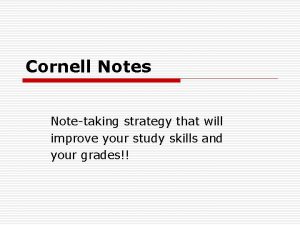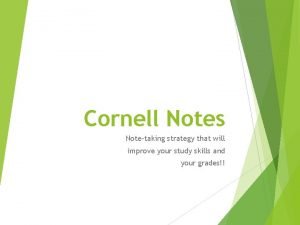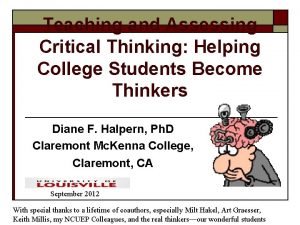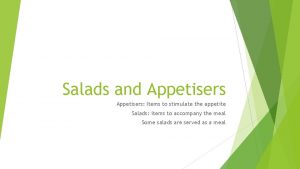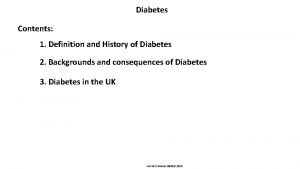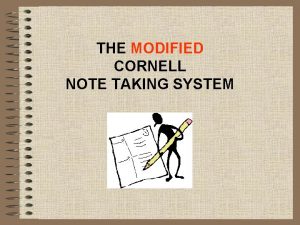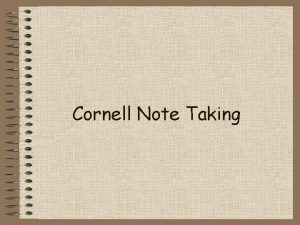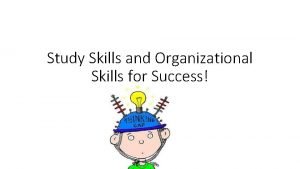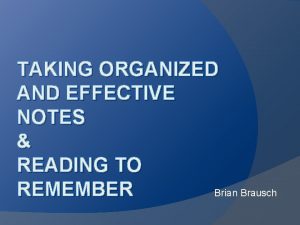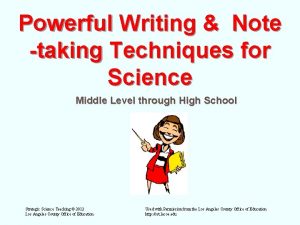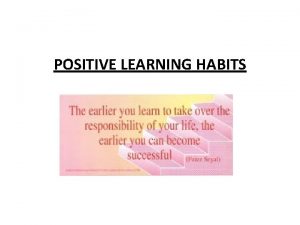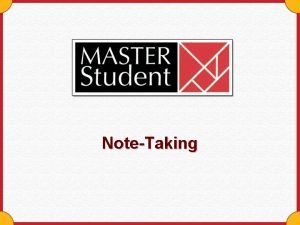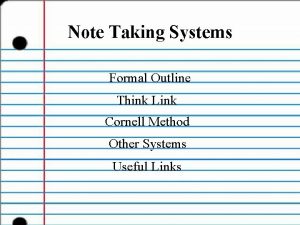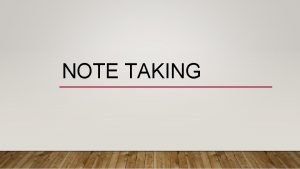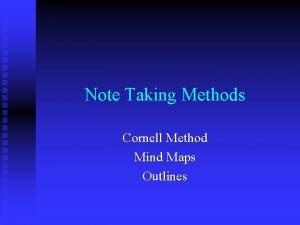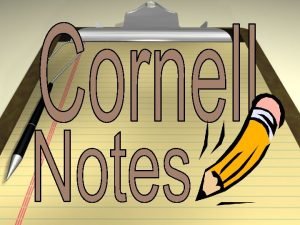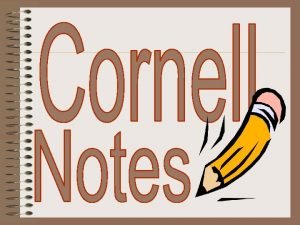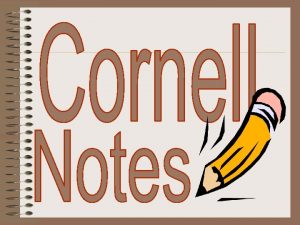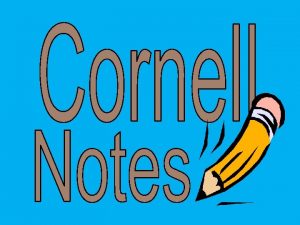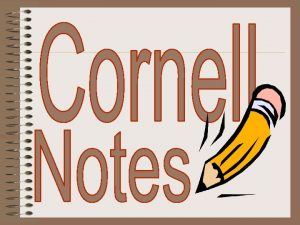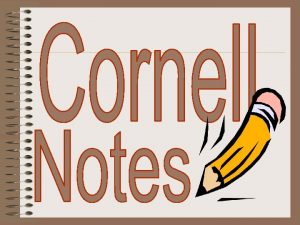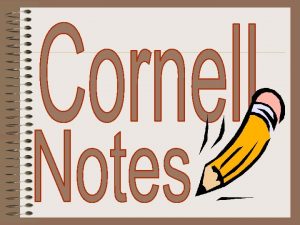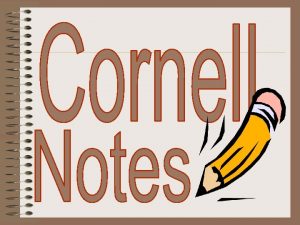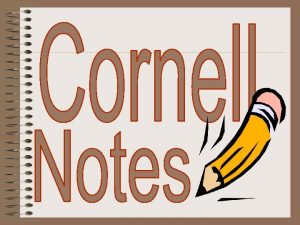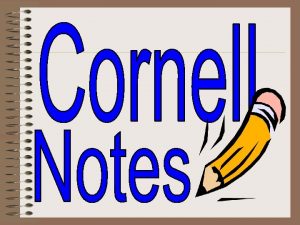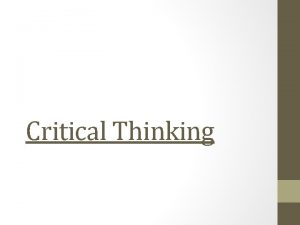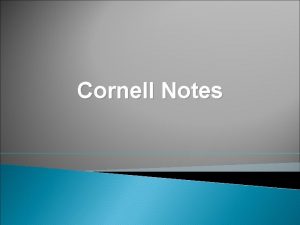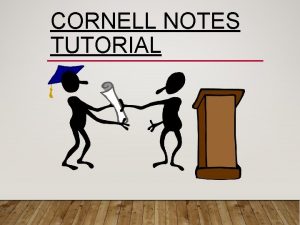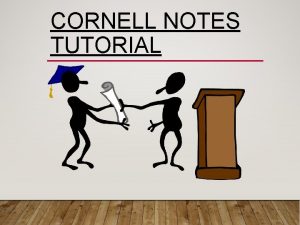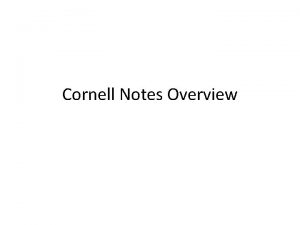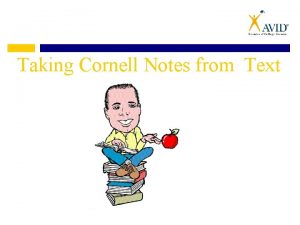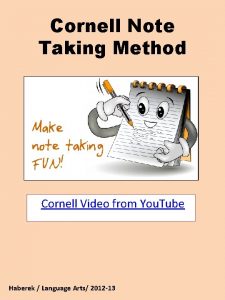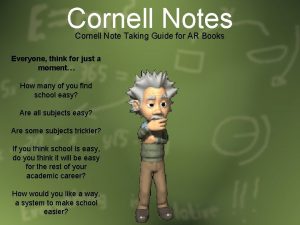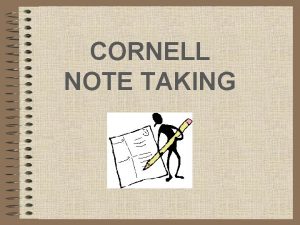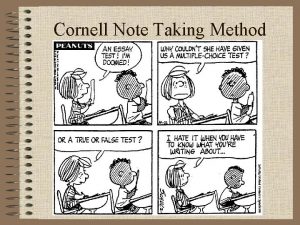Cornell note taking stimulates critical thinking skills Note

























- Slides: 25


• Cornell note taking stimulates critical thinking skills. • Note taking helps students remember what is said in class. • A good set of notes can help students work on assignments and prepare for tests outside of the classroom.

• Good notes allow students to help each other problem solve. • Good Notes help students organize and process data and information. • Helps student recall by getting them to process their notes 3 times. • Writing is a great tool for learning!

• Developed in 1949 at Cornell University by Walter Pauk. • Designed in response to frustration over student test scores. • Meant to be easily used as a test study guide. • Adopted by most major law schools as the preferred note taking method.

Topic Questions, Subtitles, Headings, Etc. First & Last Name Class Title Period Date Class Notes 2 1/2” 3 to 4 sentence summary across the bottom of the last page of the day’s notes

Subject: Why take Cornell notes? PROCESS (output) Date: 11/20/01 Main Ideas (input) Can be used to provide an outline of chapter or lecture. Organized by main ideas and details. How can Cornell notes Can be as detailed as necessary. Sequential-- take notes as they are given by instructor or help me text in an orderly fashion. organize my After class, write a summary of what you learned to ideas? clarify and reinforce learning and to assist retention. Can be used as study tool: Which side for 1. Define terms or explain concepts listed on left side. diagrams? 2. Identify the concept or term on the right side. Can be used to provide a "big picture" of the chapter or Why use concept maps? lecture. Organized by main ideas and sub-topics Limited in how much detail you can represent. Simultaneous- you can use this method for instructors who jump around from topic to topic. After class, you can add questions to the left side What are the Can be used as a study tool -- to get a quick overview benefits to me? and to determine whether you need more information or need to concentrate your study on specific topics.

• Summary is added at the end of ALL note pages on the subject (not page) • Summary added AFTER questions are finished • Summary should answer the problem stated in the subject.

1. KNOWLEDGE: recalling information 2. COMPREHENSION: understanding meaning 3. APPLICATION: using learning in new situations 4. ANALYSIS: ability to see parts & relationships 5. SYNTHESIS: Use parts to create a new whole 6. EVALUATION: judgment based on criteria

Your questions should reflect: • Info you don’t understand or want to discuss with your teacher/tutor. • Info you think would go good on an essay test. • Gaps in your notes.

Don’t forget the heading: Questions, Name, Class, Period, Date, Topic subtitles, etc. go here, in the left hand column. Remember, we want higher level critical thinking A 3 to 4 sentence summary down there questions. on the bottom of the last page of notes Notes go here, in the large right hand column.

Anthropods Paul sends his examples

Paul sends his examples

A writing technique to help focus on what you are learning in class. Writing in your learning log is a great way to use writing as a process of discovery and for clarification of ideas.

Speaker says: “Hippocrates, a Greek who is considered to be the Father of modern medicine, was Born on the island of Cos in 460 B. C. ” Notes say: “Hippocrates (Gr. ) Father of med. B. Cos 460 BC”

Be an Active Reader • Think about the reading – Consider how the parts relate to the whole; how the text relates to previous ideas – Create questions about new words/ terms, why emphasized points are important – Examine what you have learned from visuals

Be Aware of Textbook Organization • Look for the pattern in elements like chapter /subsection headings, summary points, graphics • Know where to find the index and glossary

Use the text style to identify important points • Become familiar with the font, symbols, borders, graphics, colors, and layout that highlight main ideas or terms • Be alert to the writer's goal: highlight ideas/ references /opinions that seem significant to their point of view

Take notes while reading • Include headings, key terms, & graphics • Take down only the important ideas: brief, but clear • Summarize in your own words • Use symbols to highlight for review • Use textbook review questions to develop study questions

Review textbook notes • Identify main ideas • Fill in details for better understanding • Identify unclear information and/or questions - collaborate for answers • Delete unnecessary information • Review note organization; add symbols or rewrite • Write a summary

• Use discussion topics/questions organize your notes • Use symbols for important ideas • Include your own responses in notes • Develop questions to review later • Add references to other material as they come to mind

Make use of the format • Cover the right side of your notes; review and answer study questions from the left using the right side as an answer key • Quiz yourself out loud • Cover the right side with blank paper; write out answers to the left column study questions

Write! • Write summaries of the most important material in the summary/reflection section • Write a quiz for others using notes; exchange and correct • Write anticipated test questions beyond those already in the left-hand column and write answers

Review • Look over notes frequently to keep information and questions still unanswered fresh in mind • Recite information from notes

Study in a Group • Exchange notes with others to flesh out information and understanding • Use notes in study groups to provide a common ground of material for reference and review • Rewrite notes if necessary

Designed by Paul Bullock Senior Program Specialist & Anne Maben AP Science Coach
 Cornell note taking method
Cornell note taking method Cornell note taking strategy
Cornell note taking strategy Cornell note taking strategy
Cornell note taking strategy Difference between note making and note taking
Difference between note making and note taking Signal words example sentences
Signal words example sentences Difference between note making and note taking
Difference between note making and note taking Linear method of note taking
Linear method of note taking Critical semi critical and non critical instruments
Critical semi critical and non critical instruments Semi critical
Semi critical Note taking skills
Note taking skills Perbedaan critical thinking dan creative thinking
Perbedaan critical thinking dan creative thinking Rewrite
Rewrite Type of salad which stimulate one’s appetite
Type of salad which stimulate one’s appetite Insulin stimulates
Insulin stimulates Chapter 9 cellular respiration harvesting chemical energy
Chapter 9 cellular respiration harvesting chemical energy Modified cornell notes
Modified cornell notes Cornell notes setup
Cornell notes setup Cornell skills for success
Cornell skills for success Outline method of note taking
Outline method of note taking Section 17-3 note taking guide answer key
Section 17-3 note taking guide answer key What are the five r's of note taking
What are the five r's of note taking What are the 5 r's of note taking
What are the 5 r's of note taking Note taking process
Note taking process Formal note taking
Formal note taking Prerequisites of note-taking
Prerequisites of note-taking Mind mapping note taking method
Mind mapping note taking method

